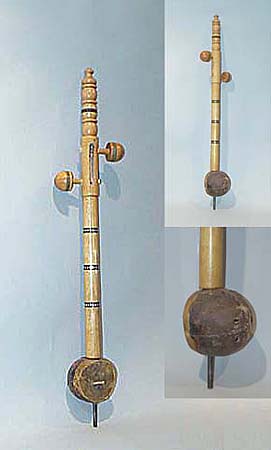
Owner: HWMC
Catalog#: 2AS-CHLT-21
Provenance: Massaro Collection
Lutes
Sri Lanka ‘Ravanahatha’
Sri Lanka
Lanka People
Wood, coconut shell, metal
Late 1900s
Length: 35 in, Width: 4.5 in, Depth: 3.8 in
Chordophones – Lutes
The ravanahatha (ravanhatta, rawanhattha, ravanastron, ravana hasta veena) is an ancient bowed, stringed instrument popular in Sri Lanka, Pakistan, and Western Indian. It is an ancient, bowed instrument made from the bowl of a coconut with goat hide serving as a resonating sound board. The neck is of wood (or bamboo) and has from one to four or more peg-tuned strings of steel (or horsehair) that are strung over a bridge.
According to Indian methology, the ravanahatha is believed to have originated among the Hela people of Lanka during the time of the legendary King Ravana, after whom the instrument is supposedly named. According to legend, King Ravana used the ravanahatha in his devotions to the Hindu God Shiva. The ravanahatha has also been suggested as an ancestor of the violin. Between the seventh and tenth centuries AD, Arab traders brought the ravanastron from India to the Near East, where it provided the basic model for the Arab rebab, and other early ancestors of the violin family.
Resource; https://en.wikipedia.org/wiki/Ravanahatha
